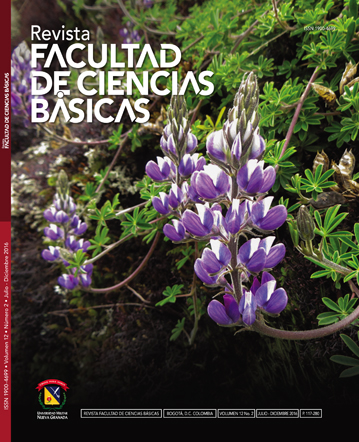LC-ESI-HRMS-Based Chemical Characterization of Lupinus bogotensis Roots
Resumo
Plants of the genus Lupinus (Fabaceae) have been studied due to the occurrence of different compounds, especially those possessing quinolizidine and isoflavone-like structures. These kinds of compounds are characterized by both medical and industrial applications, providing various benefits to human being. However, organs such as roots have not been equally studied and there is a lack of such records for native species. Therefore, in the present study, the chemical composition of nodulated roots from greenhouse-established L. bogotensis plants was determined. The resulting crude ethanolic extract was then analyzed by LC/HRMS and chemical nature of most compounds was determined by analyzing the high resolution mass spectra. Recorded profile showed adequate separation allowing tentative identification of detected compounds. 47 secondary metabolites (mainly isoflavones and quinolizidine-type compounds) were thus identified. Most phenolic compounds were found to be conjugated flavonoids (e.g., genistin and genistein malonylglucoside) and lupanine, sparteine and hydroxylupanine were noticed as the main alkaloids. Among alkaloid-like compounds, dehydromitomycin C, a compound produced by Streptomyces caespitosus was identified. Lupadienediol (a lupane-type triterpene recognized for being involved in rhizobacteria:legumes symbiosis) was the only terpene-related component identified in the extract. The present work corresponds to the first report on the chemical composition of L. bogotensis root and constitutes an adequate basis for phytoconstituents finding from nature to support the use of native species.
Downloads
Referências
• Aïnouche A, Bayer RJ, & Misset M. 2004. Molecular phylogeny, diversification and character evolution in Lupinus (Fabaceae) with special attention to Mediterranean and African lupines. Plant Systematics and Evolution, 246: 211–222.
• Barney V. 2011. Biodiversidad y ecogeografía del género Lupinus L. (Leguminosae) en Colombia. Trabajo de grado, Maestría en Ciencias Biológicas, Facultad de Ciencias Agropecuarias, Universidad Nacional de Colombia, Palmira, 69 p.
• Barsch A, Tellström V, Patschkowski T, Küster H, NiehausK. 2006. Metabolite Profiles of Nodulated Alfalfa Plants Indicate That Distinct Stages of Nodule Organogenesis Are Accompanied by Global Physiological Adaptations. Molecular Plant-Microbe Interactions Journal, 19: 998–1013.
• Bednarek P, Kerhoas L, Einhorn J, Nski RF, Wojtaszek P & Stobiecki M. 2003. Profiling of flavonoid conjugates in Lupinus albus and Lupinus angustifolius responding to biotic and abiotic stimuli. Journal of Chemical Ecology, 29: 127–1142.
• Carey D & Wink M. 1994. Elevational vartion of quinolizidine alkaloid contents in a lupine (Lupinus argentus) of the Rocky Mountains. Journal of Chemical Ecology, 20: 849–857.
• Colegate SM, Molyneux RJ. 2008. Bioactive Natural Products- Detection, isolation, and structural Determination. Boca Ratón, Fl.: CRC Press.
• Crocker J & Jones EL. 1983. Haemolytic-uraemic syndrome complicating long- term mitomycin C and 5-fluorouracil therapy for gastric carcinoma. Journal of Clinical Pathology, 36: 24–29.
• Danshiitsoodol N, Pinho CA, Matoba Y, Kumagai T & Sugiyama M. 2006. The Mitomycin C (MMC) -binding Protein from MMC-producing Microorganisms Protects from the Lethal Effect of Bleomycin : Crystallographic Analysis to Elucidate the Binding Mode of the Antibiotic to the Protein. Journal of Molecular Biology, 360: 398–408.
• Dixon RA, Paiva NL. 1995. Stress-induced phenylpropanoid metabolism. Plant Cell, 7: 1085–1097.
• El Shazly A, Ateya A & Wink M. 2001. Quinolizidine Alkaloid Profiles of Lupinus varius orientalis, L. albus albus, L. hartwegii, and L. densiflorus. Zeitschrift Fur Naturforschung, 56: 21–30.
• Fernández-Pascual J, Pueyo J, De Felipe M & Lucas M. 2007. Singular Features of the Bradyrhizobium - Lupinus Symbiosis. Dynamic Soil, Dynamic Plant, 1: 1–16.
• Gagnon H, Tahara S & Ibrahim RK. 1995. Biosynthesis, accumulation and secretion of isoflavonoids during germination and development of white lupin (Lupinus albus L.). Journal of Experimental Botany, 46: 609–616.
• Gómez-Ruiz PA, Lindig-Cisneros R, Vargas-Ríos O. 2013. Facilitation among plants: A strategy for the ecological restoration of the high-andean forest (Bogotá, D.C.—Colombia). Ecological Engineering, 57: 267–275.
• Groom A. 2012. Lupinus bogotensis. The IUCN Red List of Threatened Species 2012: e.T19891959A20097473. //http://dx.doi.org/10.2305/IUCN.UK.2012.RLTS.T19891959A200974 73, consulta junio de 2016.
• Gu L. & Gu W. 2001. Characterisation of soy isoflavones and screening for novel malonyl glycosides using high-performance liquid chromatography-electrospray ionisation-mass spectrometry. Phytochemical Analysis, 12: 377–382.
• Harborne JB. 1969). Chemosystematics of the Leguminosae. Flavonoid and isoflavonoid patterns in the tribe Genisteae. Phytochemistry, 8(8), 1449–1456.
• Hayashi HH, Huang PH, Takada ST, Obinata MO & Inoue KI. 2004. Differential Expression of Three Oxidosqualene Cyclase mRNAs in Glycyrrhiza glabra. Biological and Pharmaceutical Bulletin, 27: 1086–1092.
• Jarabo-Lorenzo A, Pérez-Galdona R, Donate-Correa J, Rivas R, Velázquez E, Hernández M, … León-Barrios M. 2003. Genetic diversity of bradyrhizobial populations from diverse geographic origins that nodulate Lupinus spp. and Ornithopus spp. Systematic and Applied Microbiology, 26: 611–623.
• Kachlicki P, Marczak L, Kerhoas L, Einhorn J & Stobiecki M. 2005. Profiling isoflavone conjugates in root extracts of lupine species with LC/ESI/MSn systems. Journal of Mass Spectrometry, 40: 1088–1103.
• Kachlicki P, Einhorn J, Muth D, Kerhoas L, Stobiecki M. 2008. Evaluation of glycosylation and malonylation patterns in flavonoid glycosides during LC/MS/MS metabolite profiling. Journal of Mass Spectrometry, 43: 572-586.
• Lane GA & Newman RH. 1987. Isoflavones from Lupinus angustifolius root. Phytochemistry, 26: 295 – 300.Long SR. 1996. Rhizobium symbiosis: Nod factors in perspective. The Plant Cell, 8:1885–98.
• Macía MJ, García E, Vidaurre PJ. 2005. An ethnobotanical survey of medicinal plants commercialized in the markets of la Paz and El Alto, Bolivia. Journal of Ethnopharmacology, 97: 337–350.
• Meredith HL. 1988. Lupin field nutrition studies. In: Proceedings 5th International Lupine Conference. Institute Plant Breeding and Acclimatization, Radzikow, Poland. 482-493 p.
• Molina D, Patiño L, Quintero M, Cortes J, Bastos S. 2014. Effects of the aspartic protease inhibitor from Lupinus bogotensis seeds on the growth and development of Hypothenemus hampei: an inhibitor showing high homology with storage proteins. Phytochemistry, 98: 69–77.
• Molina D, Zamora H, Blanco-Labra A. 2010. An inhibitor from Lupinus bogotensis seeds effective against aspartic proteases from Hypothenemus hampei. Phytochemistry, 71: 923–9.
• Osorio J, Uribe E, Molina L. 1959. Las flores de los jardines de Santa Fe de Bogotá. DAMA.
• Paul MJ, Driscoll SP. 1997. Sugar repression of photosynthesis: The role of carbohydrates in signaling nitrogen deficiency through source: sink imbalance. Plant, Cell & Environment, 20:110-116.
• Rijke E, Out P, Niessen WM, Ariese F, Gooijer C & Brinkman U. 2006. Analytical separation and detection methods for flavonoids. Journal of Chromatography A, 1112: 31–63.
• Stobiecki M, Staszków A, Piasecka A, Garcia-Lopez PM, Zamora-Natera F & Kachlicki P. 2010. LC-MSMS profiling of flavonoid conjugates in wild mexican lupine, Lupinus reflexus. Journal of Natural Products, 73: 1254–1260.
• Stobiecki M & Wojtaszek P. 1990. Note Application of gas chromatography-mass spectrometry to the identification of isoflavonoids in lupine root extracts. Journal of Chromatography, 508: 391–398.
• Torres K, Quintos N, Herrera J, Andreas T & Wink M. 1999. Alkaloid profiles of leaves and seeds of Lupinus aschenbornii Schauer from mexico. In: E. van Santen, M. Wink, S. Weissmann, & P. Roemer (Eds.), 9th International Lupin Conference, pp. 301–304. Canterbury: International Lupin Association.
• Torres KB, Quintos NR, Necha LL, Wink M. 2002. Alkaloid profile of leaves and seeds of Lupinus hintonii C. P. Smith. Zeitschrift Für Naturforschung C, 57c: 243–247.
• Vargas-Ríos O, León O, Díaz A. 2009. Restauración ecológica en zonas invadidas por retamo espinoso y plantaciones forestales de especies exóticas. Bogotá: Universidad Nacional de Colombia.
• Wink M. 2013. Evolution of secondary metabolites in legumes (Fabaceae). South African Journal of Botany, 89: 164–175.
• Wink M. 2003. Evolution of secondary metabolites from an ecological and molecular phylogenetic perspective. Phytochemistry, 64: 3–19.
• Wink M, Meißner C & Witte L. 1995. Patterns of quinolizidine alkaloids in 56 species of the genus Lupinus. Phytochemistry, 38: 139–153Wojakowska A, Piasecka A, García-López PM, Zamora-Natera F, Krajewski P, Marczak … Stobiecki M. 2013. Structural analysis and profiling of phenolic secondary metabolites of Mexican lupine species using LC-MS techniques. Phytochemistry, 92: 71–86.
• Zulak K, Liscombe D, Ashihara H & Facchini P. 2006. Alkaloids. In H. Crozier A, Clifford MN, Ashihara (Ed.), Plant Secondary Metabolites: Occurrence, Structure and Role in the Human Diet (p. 372). Oxford: Blackwell Publishing Ltd.












